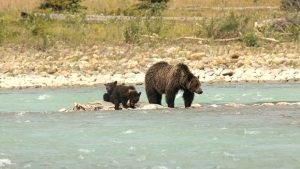
What do you get when a dead elk washes up on a gravel bar in the Athabasca River in grizzly bear habitat? In the right place, one of the best ever opportunities for the public to view a grizzly, that’s what. And not just any grizzly—a mother with two adorable cubs, born this past spring and still sporting their white fur collars, or ‘natal rings.’
For the majority of last week, this grizzly bear mama and her cubs fed on a dead elk buffet, much to the delight of hundreds of visitors and townsfolk. The grizzly did not kill the elk, but rather stumbled upon it after high water carried it down from an unknown location upstream. To find it was a caloric windfall for the young bear family, especially as other bears are currently spending hours each day searching for berries to put on winter fat.
Because of where the carcass came to rest, Parks Canada was able to set up a unique opportunity for the public to safely view the trio from a distance, while not disturbing them.
“To have such an intimate glimpse into their world without disrupting them is a rare opportunity,” said Geoff Skinner, a human-wildlife conflict specialist for Parks Canada.
Rather than spotting a bear for a fleeting moment by the side of the road, those who watched these bears saw them feed, sleep, and play. One day Skinner watched the cubs play a game of chase-the-rib-bone, stealing it back and forth from one another while racing around the shallow shore.
In a video I found online, the cubs can be seen tugging at their mother’s underside until she concedes, rolls over on her back and stretches her legs out. The cubs then climb aboard to nurse. It could only have been better if Attenborough was narrating.
Surprisingly, the three bears were disturbed little by other predators and scavengers. Wolves, foxes, ravens, and eagles all have a taste for carrion, and the smell of rot can summon them from kilometres away. Ravens alone can make a quick meal of an elk. Skinner said a couple of years back, a large group of them finished off a whole carcass in four days.
“The lack of other scavengers was likely related to the carcass being partially submerged in the river,” said Skinner. The carcass was essentially in a cold-water refrigerator that would have slowed the rotting process, and cut down on the smell. In addition, flowing water may have limited the ease with which other carrion-eaters accessed the site.
The presence of people in the area may have also acted as a deterrent for more wary carnivores like wolves and other bears. But though mama grizzly could smell the humans in the area, they didn’t appear to bother her. “She’s very comfortable moving around people,” said Skinner, adding that the Parks Canada team have been working to deter her from spending time near human developments like Lake Edith and the townsite.
Whatever the reasons, for five magical days the public observed as the young bear family went about their lives. One day I watched them from the other side of the river. I was standing beside a couple from Israel who didn’t have binoculars, so I lent them mine.
When the woman focused in and found them, she sucked in her breath so audibly, the children I was with all stopped playing to see what had happened. She was so overwhelmed by the sight of these wild creatures that her eyes welled with tears.
“Absolutely magnificent,” she said. And she was right.
Editor’s note: Niki Wilson is married to Geoff Skinner.
